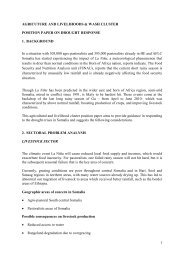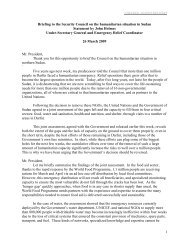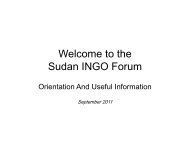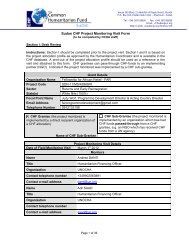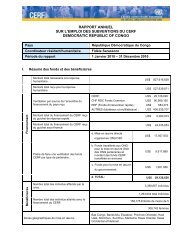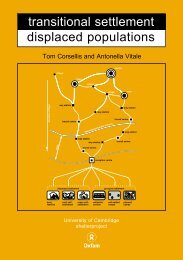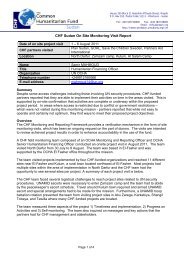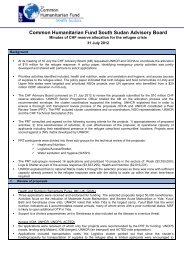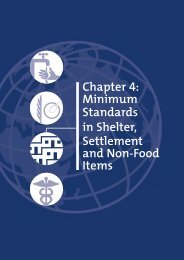Inter-Agency Real Time Evaluation of the Humanitarian ... - OCHANet
Inter-Agency Real Time Evaluation of the Humanitarian ... - OCHANet
Inter-Agency Real Time Evaluation of the Humanitarian ... - OCHANet
You also want an ePaper? Increase the reach of your titles
YUMPU automatically turns print PDFs into web optimized ePapers that Google loves.
IA RTE <strong>of</strong> <strong>the</strong> humanitarian response to Pakistan’s 2010 Floods crisis<br />
Photo 2: Group discussion with villagers in Rahm Ali Shah Village, Kot Addu, Muzaffargarh,<br />
Punjab Province © Riccardo Polastro 2011.<br />
48. Multiple single agency assessments and a lack <strong>of</strong> common formats and criteria for needs<br />
assessments have also meant that humanitarian partners have been unable to jointly prioritise<br />
interventions (see: Part six “Response”) and target most vulnerable groups within <strong>the</strong> affected<br />
population, including women and children. <strong>Inter</strong>vention prioritisation is <strong>of</strong> particular importance<br />
in a disaster such as <strong>the</strong> Pakistan floods due to its dimensions and <strong>the</strong> inability <strong>of</strong> <strong>the</strong><br />
government and international community to reach all those affected. While <strong>the</strong>re are several<br />
existing instruments, GPRS‐data and data bases identifying Pakistan’s poorest and most<br />
vulnerable populations (e.g. Pakistan Poverty Alleviation Fund, <strong>the</strong> National Rural Support<br />
Programme, <strong>the</strong> Benazir Income Support Programme, etc.), <strong>the</strong>se were not sufficiently<br />
incorporated and used during <strong>the</strong> assessments.<br />
49. Access has been ano<strong>the</strong>r problem, particularly at <strong>the</strong> beginning <strong>of</strong> <strong>the</strong> emergency<br />
primarily due to infrastructure damages and security concerns, as well as access granted by<br />
authorities before <strong>the</strong> No Objection Certificate (NOC) was installed. On a more permanent basis,<br />
access issues have been related to security concerns, especially in <strong>the</strong> FATA, Balochistan, Khyber<br />
Pakhtunkhwa (KP) and parts <strong>of</strong> Punjab.<br />
50. The lack <strong>of</strong> access prevented organizations from carrying out independent needs<br />
assessments. Instead, organizations were <strong>of</strong>ten directly given lists <strong>of</strong> beneficiaries by <strong>the</strong> local<br />
administration or feudal landlords. These beneficiary lists were not always verified or prioritized.<br />
Riccardo Polastro, Aatika Nagrah, Nicolai Steen and Farwa Zafar<br />
31




